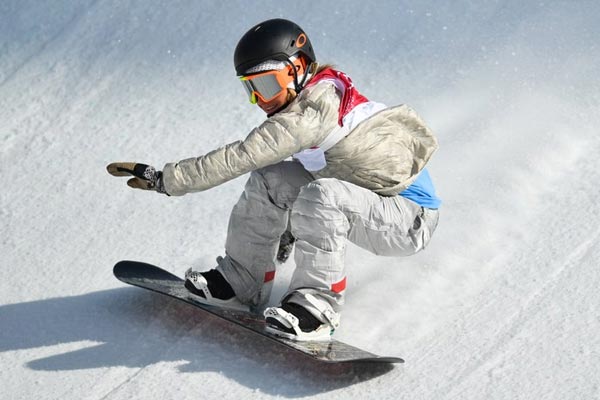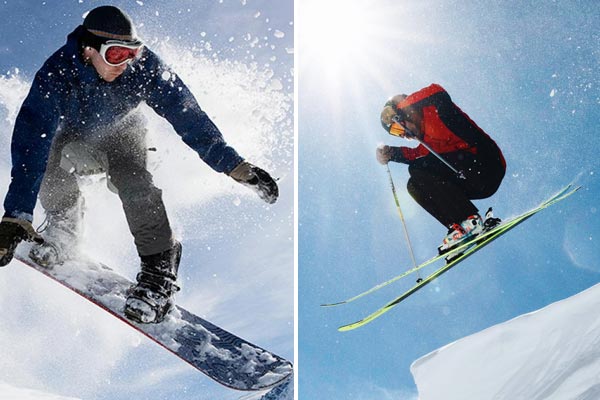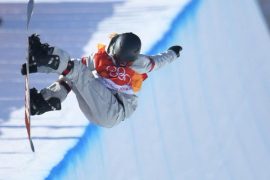Snowboarding can be an exciting experience that can get your adrenaline rushing and your pulse racing.
Obviously, if you’re reading this, you are either planning to go snowboarding or considering the possibility at least.
With that being said, doing anything for the first time can be an intimidating process, particularly when making a mistake can ruin the whole thing.
So, we’ve got you covered: this article will delve into everything you need to know about snowboarding, from what it is and where it started to the best places to go and the equipment you need to pack with you.
What is snowboarding?
Similar to skiing, snowboarding is a winter sport that requires speed, precision, and skill.
The website skicanada.org defines snowboarding as “a winter sport that involves descending a slope that is covered with snow while standing on a board attached to a rider’s feet, using a special boot set onto a mounted binding.”
However, unlike skiing, a single board is used, there are no poles involved, and the person faces sideways instead of looking forwards.
With that being said, there are three main types of snowboarding: freestyle, freeriding, and alpine (also known as free carving).
Types of snowboarding:
According to Torah Bright, gold medal-winning snowboarder, each style of snowboarding can be broken down into multiple subtypes. Let’s take a look at that:
Freestyle snowboarding
Similar to what skateboarders do, freestyle snowboarding involves the use of both natural and man-made elements to perform tricks: For example, performing spins, corks, in a halfpipe would be considered freestyling.
Other types of freestyle include slopestyle, where a snowboarder goes down a slope and does tricks over obstacles; urban and jibbing, where a snowboarder rides surfaces other than snow, such as metal rails, boxes, and benches; big air, where a snowboarder takes a huge jump and does a few tricks while in the air; and rail jam, where a snowboarder rides a rail set-up or other urban-like features.
Freeriding
Whereas freestyle focuses on doing tricks, regardless of the setting where these tricks are performed, freeriding relies on the usage of natural terrain and natural challenges.
Rather than performing tricks, the goal of freeriding is to be able to maneuver in that natural terrain.
Two of the most popular types of freeriding is backcountry and big mountain on the one hand and backcountry freeride competitions on the other.
In backcountry and big mountain, snowboarders ride through wild terrain, down large mountains, and on deep snow, all of which require a strategic approach.
Alternatively, backcountry freeride competitions invite snowboarders to race down mountains, but this form is relatively rare given how dangerous it can be.
Alpine snowboarding
Also dubbed as free carving, alpine snowboarding entails snowboarders using the already existing infrastructure in place for skiing.
It first started as a racing competition but evolved into a competition that combines racing with tricks, such as carving at high speeds.
Alpine snowboarding consists of two main subtypes: slalom racing and snowboard cross.
Slalom racing is similar to ski racing in the sense that involves an individual racing down a course while crossing by poles jutting out from the snow.
As for snowboard cross, which is also called boardercross, it is an event that pits several snowboarders against one another directly and has them descend simultaneously rather than timing their individual descents, as in slalom racing.
What is the history of snowboarding?
The commonly held belief is that snowboarding started in the United States of America; as a matter of fact, the engineer Sherman Poppen is thought to have invented the first precursor to today’s modern snowboard back in 1965.
Word is that Poppen was designing a toy for his daughters when he came upon the idea of bolting two skis together and attaching a rope to the front for the purposes of steering this contraption, which was nicknamed the “Snurfer” by Poppen’s wife.
Subsequently, the Brunswick Corporation, a company that manufactures sports equipment, saw Poppen’s little invention and decided to get in on the action.
The company licensed the “Snurfer” and sold it to the entire nation, a successful endeavor that saw the Brunswick company sell more than a million “Snurfers” by the end of the seventies.
After that, the “Snurfer” kept evolving and changing over the years till we ended up getting modern snowboards as we know them.
Throughout this process of evolution, numerous inventors and athletes contributed with their ideas and refinements: Dimitrije Milovich gave us the “Winterstick,” Jake Burton carpenter gave us Burton Snowboards, Tom Sims gave us Sims Snowboards, and Chuck Barfoot gave us Barfoot Snowboards.
Once snowboards became ubiquitous enough among winter sports enthusiasts, snowboard manufacturers started organizing competitions, the first of which was held in 1982 in Vermont.
Nevertheless, snowboarding didn’t garner real popularity with the wider mainstream audience till 1985, when there was a snowboarding scene in the James Bond film “A View to a Kill.”
However, it wasn’t until 1994 that the International Olympic Committee (IOC) finally recognized snowboarding, and the sport made its Olympic debut in the 1998 Winter Games, which were held in Japan that year.
Ever since then, snowboarding has been a constant presence in the Olympic Winter Games, with events like the halfpipe and snowboard cross being extremely popular.
Not only are snowboarding events the centerpieces of the Olympic Winter Games, but the sport’s athletes have also gained a sort of celebrity status and fame that is not too different from what actors and singers enjoy.
For example, Shaun White, a snowboarder who’s won multiple medals and is considered as one of the best out there, has become a household name and has had multiple cameos in blockbuster films.
So, what do you need to know if you are about to go snowboarding for the first time?
Hopefully, by now, you are excited to go snowboarding and are wondering how to best get started. First of all, we need to take a look at what you’ll need:
What do you need?
When starting out, it’s best to rent most of your gear instead of buying it. This is for several reasons.
To start with, you don’t want to commit yourself until you are sure that you enjoy snowboarding and would like to take it up.
Also, seeing as you will be starting out, you are better off having a shop owner help you pick out the gear that is most suitable for someone at your level.
Nonetheless, there are a few pointers that any beginner should know. When choosing a board, beginners are advised to go for a basic flat profile board, one that has a slight rocker on either you’re your board will most likely be 5 feet long and 10 inches wide.
When choosing the snowboarding boots, it is important to pick something that fits you perfectly, something that neither squishes your toes nor prevents your heel from keeping contact with the bottom of the boot when it is lifted.
However, there are some things that you’ll have to buy; chief among them is your clothing. It is worth remembering that you will probably fall a lot during your first few times, meaning that you’ll be covered in snow.
Therefore, you need clothes that’ll keep you warm while keeping you from getting wet. So, you should buy yourself some thick gloves, a warm jacket, and comfortable pants. But, stay away from jeans.
In addition to staying warm, you need to think about your safety, which is why it is advisable to either rent or buy a helmet, goggles, and wrist guards.
Should you wish to provide yourself with extra protection, you can buy special pads to protect your tailbone when you fall.
How much will all of this cost you?
Naturally, you’re asking yourself what’s the damage on all of that equipment, especially for beginners?
Unfortunately, it’s not cheap, and that is all the more true for those who have to start from scratch and can’t borrow any of the above equipment from their friends.
According to the website snowboardinghelp.com, renting a snowboard, along with the boots, bindings, lift ticket, and the lesson could cost you somewhere in the range of $40 to $60.
On the other hand, if you wish to buy your equipment, then buying a board, boots, goggles, and gloves could cost you around $800.
Although the above prices might strike you as reasonable, the real damage comes from the clothes you have to purchase.
The jacket alone can cost you a ballpark figure of $150 to $300, and the pants go for about $100 to $240.
Moreover, when you add an extra $100 for the socks, your grand total for clothes alone arrives at an average of $500. Over and above, none of this mentions the lift passes.
The good news is that most of these prices are a one-time investment that you pay and then never have to worry about again, and this is contingent on you wanting to take snowboarding up and to have your own equipment rather than having to rent them all the time.
Having made up your mind that you want to go snowboarding and saved enough to make that a reality, the next question to ask is where should you go as a beginner?
What are the best places for beginners to go snowboarding?
Of all the places that you, as a beginner, can go snowboarding, it is best to start with an artificial setting, where you will have more control than if you were out in the wild. Hence, your best options are either a snow dome or a dry slope.
A snow dome is an indoor man-made slope that uses snowmakers to mimic natural slopes.
The best thing about a snow dome is that it is open all year round as it doesn’t rely on the weather to offer you the experience of being surrounded by snow.
Alternatively, dry slopes tend to be situated outdoors, where artificial hills are engulfed by carpets that simulate the friction given off by snow.
Yet, if you have your heart set on learning on real snow, then you have several options to choose from.
For those who live in Europe or are able to travel there, you can head over to Scotland, France, Switzerland, Austria, or Italy, all of which are popular choices among snowboarding beginners.
As for those who live in the States, you also have a plethora of choices; just be sure to steer clear from Mad River Glen, Alta, and Deer Valley has given that snowboarding is banned there.
Is there anything else you should know?
Finally, once you’re all prepared, it is time to go snowboarding. With that being said, you need to be aware that you will fall multiple times, and you shouldn’t be frustrated by that.
However, a good way to accelerate your learning curve is to hire the services of a professional trainer who will be patient with you and will know how to give you the necessary instruction.
You can either join a group lesson or go private; the choice is up to you. A group lesson is relatively cheap, whereas a private lesson allows you to benefit from a one-on-one interaction in order to learn faster.
It is worth knowing that several resorts offer package deals to beginners, where equipment rentals, group lessons, and lift tickets are all grouped together.
As a first time snowboarder, here are a few rules and tips for you to follow:
As a new snowboarder hitting the slopes for the first time, there are a few rules you ought to be aware of:
1. It is important to learn how to be in control early on so as to avoid injuring other people using the slopes with you. As a result, the first thing you need to learn is how to stop and slow down.
2. Anybody on the slope in front of you has the right of way, which means that you’re the one who has to watch out for them and avoid colliding with them.
3. It is very important to avoid stopping in the middle of the trail where you will obstruct the motion of your fellow skiers and snowboarders. However, if you have to stop, you need to make sure that you are visible to other people coming down behind you.
4. When beginning a downhill descent or joining a trail, you should take the time to look uphill first and give the right way to people already descending.
5. It is important that you avoid having your equipment run away from you.
6. Posted signs and warnings are there for your safety; you need to do as they say at all times. Moreover, if an area is closed off, stay out of it; it’s most likely closed for a reason.
7. Before getting on a lift, you should make sure that you know how to get on and off one.
Other tips that might be helpful to you and your loved ones:
Aside from the above rules, there are several tips that can help you have an enjoyable experience:
1. It helps if you get in shape before you go snowboarding. After all, odds are you’ll be falling and getting up multiple times, which will require a good arm and leg strength. As well as this, having good core strength can help you with your balance.
2. Throughout the years, snowboarding has managed to accumulate its unique lingo. If you are serious about learning the sport, then it would help to learn this lingo, and here is a glossary to help with that.
3. When snowboarding, keep your eyes in front of you and on the path. This may be a bit difficult for beginners, whose eyes tend to look down on the board.
4. Snowboarders are either goofy or regular; you should try to figure which one you are early on. Regular snowboarders tend to have their left foot forward, while goofy snowboarders feel more comfortable with their right foot forward.
5. One of the best ways to keep your balance is to keep your center of gravity above the board. You can achieve this by picturing an imaginary line running through your entire body, from the top of your head all the way to your bottom. Your objective should be to keep that line running through your board.
6. This one is a bit counterintuitive. The faster you go, the easier things will be for you. In other words, you will find turning and be maneuvering the board easier to do when you are rushing down a slope rather than when you are going at a snail’s pace.
7. Seeing as you will be out in the sun for a long time, it is always a good idea to put on a little sunscreen to protect your skin.
8. Most important of all, make sure to have fun. If you aren’t enjoying the experience, then you’re doing it wrong.
Here are a few how-to pointers to get you started:
We are so excited about you trying out snowboarding that we don’t want to wait till you’re on the slopes to get your first lesson.
Instead, we will go over a few basics with you so that you can hit the ground running the instant you’re strapped into your snowboard:
What is the best way to slow down or even stop on a snowboard?
When it comes to stopping on a snowboard, the edge of the board is your friend. After all, by digging the edge of your board into the snow, you can slow your movement and bring yourself to a complete halt.
This act of digging the edge of the board into the snow can be done in one of two ways:
You can use your toes and push them down into the snow in order to slow down.
The harder you push your toes, the faster you will slow down. The other side of that coin is what is known as heel side braking, where you dig your heels into the snow when you want to decelerate.
If you want to stop abruptly, you can resort to a snowplow stop. In a snowplow stop, you spin yourself so that you are facing forwards instead of sideways and your board becomes perpendicular to your direction of motion.
Afterward, you need to dig your heels and raise your toes, which will make the entire edge of your board go against the snow.
For a better idea on how you can stop, you can check out this short video that details the best ways to better control your board.
What is the best way to turn?
When snowboarding, turning, which is also known as carving, can be a tricky matter. The best way to do that moves your center of gravity forwards or backward ever so slightly, depending on which direction you wish to go.
Occasionally, you will shift your weight too much, causing you to lose balance and tip over. This is a very natural thing and is part of the learning curve.
However, if you keep your knees bent, avoid riding your board flat, and manage to keep your weight on your leading foot, you can minimize the number of times you fall.
After you become experienced with making single turns, you can begin performing several turns in quick succession. This is called linking turns.
What is the best way to get on and off the lift?
The main problem with sitting on the lift is that your board becomes perpendicular to the direction you want to move in.
As a result, during a dismount, it is important to know how to twist sideways so that the board is facing the right direction as it hits the ground.
It is a lot easier than it sounds, and all it needs is a little practice.


